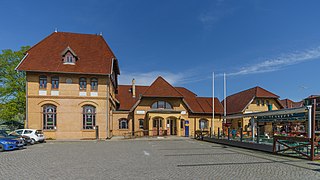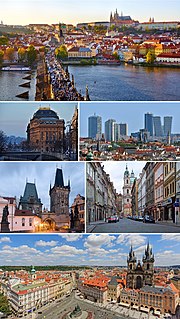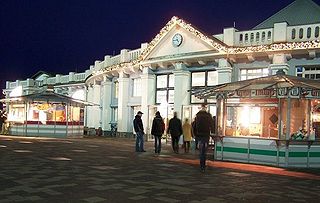
East Germany, officially the German Democratic Republic, was a country that existed from 1949 to 1990, when the eastern portion of Germany was part of the Eastern Bloc during the Cold War. It described itself as a socialist "workers' and peasants' state", and the territory was administered and occupied by Soviet forces at the end of World War II — the Soviet Occupation Zone of the Potsdam Agreement, bounded on the east by the Oder–Neisse line. The Soviet zone surrounded West Berlin but did not include it; as a result, West Berlin remained outside the jurisdiction of the GDR.

West Berlin was a political enclave which comprised the western part of Berlin during the years of the Cold War. There was no specific date on which the sectors of Berlin occupied by the Western Allies became "West Berlin", but 1949 is widely accepted as the year in which the name was adopted. West Berlin aligned itself politically with the Federal Republic of Germany and was directly or indirectly represented in its federal institutions.

Deutsche Bahn AG is a German railway company. Headquartered in Berlin, it is a private joint-stock company (AG), with the Federal Republic of Germany being its single shareholder.

The Deutsche Reichsbahn or DR(German Reich Railways) was the operating name of state owned railways in the German Democratic Republic, and after German reunification until 31 December 1993.
Transdev Germany is the largest private operator of passenger buses and trains in Germany. It is a subsidiary of Transdev.

The Berlin Stadtbahn is a major railway thoroughfare in the German capital Berlin, which runs through Berlin from east to west. It connects the eastern district of Friedrichshain with Charlottenburg in the west via 11 intermediate stations including Hauptbahnhof. The Berlin Stadtbahn is often also defined as the slightly longer route between Ostkreuz and Westkreuz, although this is not technically correct.

Slovenská strela is the name of an express train, first operated by ČSD in Czechoslovakia on the line between Bratislava and Prague.

The Děčín–Dresden railway, also called the Elbe Valley Railway is an electrified main line in Saxony and the Czech Republic. Formerly called the Saxon-Bohemian State Railway, the line is part of the Dresden to Prague route and is one of Europe's most important trunk routes (Magistralen). It runs along the Elbe Valley from Děčín via Bad Schandau and Pirna to Dresden. The first section of the line was opened in 1848 and is one of the oldest lines in Germany.

The Neustrelitz–Warnemünde Railway is a railway line in the North German state of Mecklenburg-Vorpommern. Most of the line is a double-tracked, electrified main line and runs for almost 130 kilometres from Neustrelitz to Warnemünde. It is also known in German as the Lloydbahn, referring to the Deutsch-Nordischer Lloyd company, which built the line and operated it in its early years after its opening in 1886.
The Ludwigslust–Wismar railway is an electrified railway in the German state of Mecklenburg-Vorpommern. The Ludwigslust–Bad Kleinen section of the line is double track. The line was opened in 1848 by the Mecklenburg Railway Company and is one of the oldest railways in Germany.

The Lübeck–Bad Kleinen railway is a single-track, non-electrified main line between the German states of Schleswig-Holstein and Mecklenburg-Vorpommern. Its construction was started by the Lübeck-Kleinen Railway Company and, after that company’s bankruptcy, it was completed and opened by the Friedrich-Franz Railway (Friedrich-Franz-Eisenbahn).

Hungaria is a EuroCity train which runs between Budapest Keleti and Berlin Hauptbahnhof, currently running with coaches of MÁV. It is numbered as EC 172-173 and runs daily, mainly with MÁV owned rolling stocks.

Berolina was a named passenger train between Warsaw and Berlin via Frankfurt (Oder). Introduced in 1959, it went through a number of iterations, including a short period without a name. Part of the Interexpress network as IEx 242/243 from 1986, it became categorised as EuroCity trains 42 and 43 in 1992. The service was finally replaced by the Berlin-Warszawa-Express in 2002.

Varsovia, the New Latin word for Warsaw, Poland, has been the name of two distinct EuroCity international express trains, each of them originating and terminating in Warsaw.
The Primator was an international express train. Introduced in 1986, it ran between Prague, then the capital of Czechoslovakia, and East Berlin, then the capital of the German Democratic Republic (GDR).
The Porta Bohemica is a EuroCity (EC) international express train. Since December 2014 it is operating between Hamburg-Altona and Budapest Keleti.
The Comenius has been the name of two distinct EuroCity (EC) international express trains, both of them originating, terminating or passing through Prague, the capital of the Czech Republic.

The Wawel was an international named express train. Introduced in 1995 as an InterCity service, it was upgraded to EuroCity status by operating PKP Intercity and DB Fernverkehr in 2006. The service was withdrawn at the end of 2014.

Warnemünde station is located in the seaside resort of Warnemünde, a district of the Hanseatic city of Rostock in the German state of Mecklenburg-Vorpommern. The station opened on 30 September 1903 and is located on the Neustrelitz–Warnemünde railway. It is the terminus of all three Rostock S-Bahn lines. In addition, some long-distance trains serve the station. Until 1995, it was the starting point of ferries to Gedser in Denmark. The station building and some other facilities of the station have heritage protection.





















